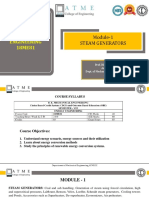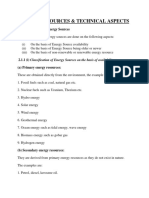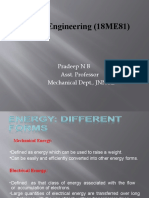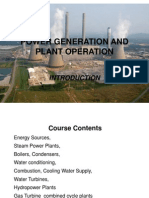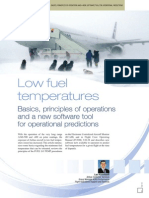Unit I
Unit I
Uploaded by
Priyanka VedulaCopyright:
Available Formats
Unit I
Unit I
Uploaded by
Priyanka VedulaOriginal Title
Copyright
Available Formats
Share this document
Did you find this document useful?
Is this content inappropriate?
Copyright:
Available Formats
Unit I
Unit I
Uploaded by
Priyanka VedulaCopyright:
Available Formats
J.
Divya Navamani
Classification of Energy resources:
Based on usability of energy
Based on traditional use
Based on long-term availability
Based on commercial application
Based on origin
The contemporary non-conventional sources of energy like wind, tidal, solar etc. were the
conventional sources until James Watt invented the steam engine in the eighteenth century.
In fact, the New World was explored by man using wind-powered ships only. The nonconventional
sources are available free of cost, are pollution-free and inexhaustible.
Man has used these sources for many centuries in propelling ships, driving windmills for grinding
corn and pumping water, etc. Because of the poor technologies then existing, the cost of
harnessing energy from these sources was quite high. Also because of uncertainty of period of
availability and the difficulty of transporting this form of energy, to the place of its use are some of
the factors which came in the way of its adoption or development.
The use of fossil fuels and nuclear energy replaced totally the non-conventional methods because
of inherent advantages of transportation and certainty of availability; however these have polluted
the atmosphere to a great extent. In fact, it is feared that nuclear energy may prove to be quite
hazardous in case it is not properly controlled.
Energy resources are mined or otherwise obtained from the environment.
a. Fossil fuels: coal, lignite, crude oil, Natural gas etc.
b. Nuclear fuels: Uranium, Thorium, other nuclear used in friction
reaction.
c. Hydro energy : It is energy of falling water, used to turn a turbine.
d. Geo thermal: The heat from the underground stream .
e. Solar energy: Electromagnetic radiation from the Sun.
f. Wind energy: The energy from moving air used by wind mills.
g. Tidal energy: The energy associated with the rise and fall of the tidal
waters.
Indias per capita energy consumption has grown at CAGR of 3.44% during 1970-71 to 2010-11.
At the current level of 4816 KWH (2010-11), this is lowest amongst all major developing
economies in the world.
The fact that India is dominated by a rural population at 69%, which largely depends on non
commercial sources to meet its energy needs also contributes to the low recorded per capita
energy consumption.
As per 2011 Census data, percentage of rural households using
Firewood 62.5%,
Crop residue 12.3%
cow dung 10.9% as primary cooking fuel.
Percentage of households owning
2 wheelers 21%
4 wheelers 4.7%,
only 47.2% households use televisions. As this segment of India, otherwise known as bottom of
the pyramid moves towards urbanization with higher disposable income for better standard of
living, the energy demand is set to go up significantly.
Coal dominates the countrys energy mix with a robust 52% share in primary energy
consumption, followed by oil at 30% and gas at 10%. Other sources include 2%
hydroelectricity and less than a percent nuclear energy.
Import dependence of oil consumption is currently about 75%, which is projected to
increase to 80% by 2016-17. Import component of gas is currently ruling at 19%,
slated to increase to 28% by 2016-17. Similarly, coal import is expected to rise from
about 90 million tons at present to over 200 million tons in 2016-17.
By 2030, the total energy requirement for the country would
increase to 400,000 MWs from the existing 185,000 MWs. Ideally
India has to plan for 215,000 MWs of power to be realized from
renewable energy resources like hydel, wind, solar, nuclear and
conversion of municipal waste into energy by 2030.
India is committed towards increasing the share of renewable power in the
electricity mix to 15 per cent by the year 2020.
The National Solar Mission targeting 20,000 MW grid solar Power, 2,000
MW of off-grid capacity including 20 million solar lighting systems and 20
million square meters solar thermal collector area by 2022 is under
implementation.
Wind power is the fastest growing renewable energy sectors in India. A total
capacity of 15,880 MW of wind power has been installed in the country. A
capacity of around 2827 MW has been installed during 2011.
COAL:
India has about 5% of world's coal production. The major states known for coal reserves
are Bihar, Orissa, West Bengal, Madhya Pradesh, Andhra Pradesh and Maharashtra.
OIL AND NATURAL GAS:
In India oil was first found at Makum (North East Assam) but drilling of oil was
started at Digboi in Lakhimpur district. After independence, at Gujarat plains and Bombay
High, major oil reserves were found. Lately, oil deposits were found in offshore areas off
the deltaic coasts of Godavari, Krishna, Kaveri and Mahanadi.
Natural gas reserves are generally found in association with oil fields. However, exclusive
gas reserves are also located in Tripura, Rajasthan and almost all the offshore oil fields of
Gujarat, Maharashtra,Tamil Nadu, Andhra Pradesh and Orissa .
Nuclear Power:
A small quantity of radioactive material can produce an enormous amount
of energy. For instance one ton of Uranium-235 would provide as much
energy as produced by 3 million tons of coal or 12 million barrels of oil.
India is rich in certain radioactive materials. Uranium mines are located in
Singhbhum in Bihar and parts of Rajasthan. Most abundant Monazite sands
are present on the shores of' Kerala.
Thorium is derived from the monazite sands. The major nuclear power
plants in our country are located in Tarapur (Maharashtra), Kota
(Rajasthan), Kalpakkam (Tamilnadu), Kakarpara (Gujarat), Kaswar
(Karnataka) and Narora (Uttar Pradesh).
Coal is the organic fossil material which is solid and black in colour with
varying properties and composition. It is essentially rich in amorphous
carbon and contains several liquid and gaseous hydrocarbons.
Types of coal:
Anthracite (hard coal)
Bituminous (Soft coal)
Lignite (Brown coal)
Peat
a) Anthracite (hard coal)
It is hard, black, lusturous, shiny and dense.
This is the highest grade coal with calorific value of 8,250 to 8,700 kcal/kg.
It contains 86-98% of carbon.
Volatile matter is low being just 2-14%.
It is not found in India. It mainly occurs in UK & USA.
b) Bituminous (Soft coal) :
It is also high grade coal next to anthracite.
It has a calorific value in the range of 7,500 to 8,700 kcal/kg. It contains about 46-86% carbon.
Volatile matter is low and can be removed by heating in the absence of air, when it gets
converted into coke. More the volatility, lower is the heating value.
C) Lignite (Brown coal)
It is inferior quality, low grade coal.
Its calorific value is 6,150 to 7,300 kcal/kg.
It has a moisture content of about 30-50% before exposure to air.
Its volatile matter is about 30%.
Lignite when exposed to air gets oxidised.
.
d) Peat
Peat is a solid fuel with highest moisture content.
It is not fully matured form as it is partially decomposed, so it is not
true coal.
Its heating value is much less and is lower than that of wood.
It has about 90% moisture.
It is used as a low grade fuel.
IMPORTANT PROPERTIES OF COAL
The most important properties of coal for energy evaluation are follows:
- Calorific value (Heating Value)
- Volatile matter
- Carbon Content
Various production technologies involve exploration, mining,
preparation, sorting, cleaning, storage and transportation.
The coal conversion technologies include coal gasification, liquefaction,
coal slurry, coal carbonisation for coke and coal gas production.
Coal mining is done in two distinct ways:
Surface mining, in which the coal beds are near the ground surface with little
over-burden of soil (depth < 30 m).
Underground mining - here the coal beds are located at depths.
After mining, the coal is prepared to make it suitable for a particular
use. The coal is purified by removing dirt, mud etc.
Coal is converted from solid form to liquid or gaseous form also.
Various solid, and gaseous fuels have their specific application. Direct
burning of coal results - emission of particulates, smoke, SOx - NOx,
CO and CO
2
. The gaseous or liquefied fuels cause lesser pollution.
Old English term col, which has meant "mineral of fossilized carbon" since the 13th
century
IGCC is a combination of two leading technologies.
The first technology is called coal gasification, which uses coal to create a clean-burning gas
(syngas).
The second technology is called combined-cycle, which is the most efficient method of producing
electricity commercially available today.
Coal Gasification:
The gasification portion of the IGCC plant produces a clean coal gas (syngas) which fuels the
combustion turbine.
Coal is combined with oxygen in the gasifier to produce the gaseous fuel, mainly hydrogen and
carbon monoxide.
The gas is then cleaned by a gas cleanup process.
After cleaning, the coal gas is used in the combustion turbine to produce electricity.
An integrated gasification combined cycle (IGCC) is a technology that uses
a gasifier to turn coal and other carbon based fuels into gassynthesis gas
(syngas).It then removes impurities from the syngas before it is combusted.
Some of these pollutants, such as Sulfur can be turned into re-usable
byproducts. This results in lower emissions of sulfurdioxide, particulates, and
mercury. With additional process equipment, the carbon in the syngas can be
shifted to hydrogen via the water-gas shift reaction, resulting in nearly carbon
free fuel. The resulting carbon dioxide from the shift reaction can be
compressed and stored. Excess heat from the primary combustion and syngas
fired generation is then passed to a steam cycle, similar to a combined cycle
gas turbine. This results in improved efficiency compared to conventional
pulverized coal.
Coal liquefaction is a general term referring to a family of processes for producing
liquid fuels from coal.
Specific liquefaction technologies generally fall into two categories:
direct (DCL)
indirect liquefaction (ICL) processes.
Indirect liquefaction processes generally involve gasification of coal to a mixture
of carbonmonoxide and hydrocarbon(syngas) and then using a process such as
Fischer-Tropsch to convert the syngas mixture into liquid hydrocarbons.
By contrast, direct liquefaction processes convert coal into liquids directly, without
the intermediate step of gasification, by breaking down its organic structure with
application of solvents or catalysts in a high pressure and temperature
environment.
Fischer-Tropsch Indirect Liquefaction Process
- Yields high quality transportation fuels plus other products
While burning coal, a lot of pollution occurs. So there is a need to burn coal
in cleaner way. Fluidized Bed combustion is one such important technology,
in while coal is crushed and mixed with bits of limestone and propelled into
a furnace in strong current of air .
The particles mix turbulently in the combustion chamber ensuring very
efficient combustion and therefore, low levels of carbon monoxide are
produced.
The furnace also operates at a much lower temperature than a conventional
coal boiler, thus reducing nitrogen oxide emissions.
The limestone reacts with sulphur oxides producing calcium sulphite or
sulphate, thus reducing SOx emissions from the stacks
It was in 1859, when a steel drill in Pennsylvania hit 20 meters and a black,
foul smelling liquid came gushing from a well. This was the dawn of a new
energy era. This was petroleum and just less than a century later, this oil
became the world's most important energy resource.
Being liquid and relatively easy-to transport long distances, either by ship or
by pipeline, oil has been accepted as an ideal fuel. It burns cleaner than
coal, but less cleaner than natural gas.
Oil is also obtained from
oil shales
sand tars.
Oil shale, also known as kerogen shale, is an organic-rich fine grained sedimentary rock
containing kerogen (a solid mixture of organic chemical compounds) from which
liquid hydrocarbons called shale oil (not to be confused with tight oilcrude oil occurring naturally
in shales) can be produced. Shale oil is a substitute for conventional crude oil; however, extracting
shale oil from oil shale is more costly than the production of conventional crude oil both financially
and in terms of its environmental impact.
Deposits of oil shale occur around the world, including major deposits in the United
States.
Shale oil, known also as kerogen oil or oil-shale oil, is an unconventional oil produced from oil
shale by pyrolysis, hydrogenation, or thermal dissolution. These processes convert the organic
matter within the rock (kerogen) into synthetic oil and gas. The resulting oil can be used
immediately as a fuel or upgraded to meet refinery feedstock specifications by
adding hydrogen and removing impurities such as sulfur and nitrogen. The refined products can be
used for the same purposes as those derived from crude oil.
Oil sands, tar sands or, more technically, bituminous sands, are a
type of unconventional petroleum deposit..
The oil sands are loose sand or partially consolidated sandstone
containing naturally occurring mixtures of sand, clay, and
water, saturated with a dense and extremely viscous form
of petroleum technically referred to as bitumen (or colloquially tar due
to its similar appearance, odour and colour). Natural bitumen deposits
are reported in many countries, but in particular are found in extremely
large quantities in Canada. Other large reserves are located in
Kazakhstan and Russia.
Natural gas is primarily methane (CH
4
). Like coal and oil, it is a
fossil fuel. It was given off by decomposing plant and animal
remains that were buried in the earth by sedimentary deposits for
millions of years. That is why, natural gas deposits often accompany
coal and oil deposits.
Natural gas is the cleanest fossil fuel. It can be easily transported
within the country by pipeline. It is used primarily for heating
buildings, home cooking, industrial processes and generating
electricity.
At normal temperature and pressure, the contents of commercial natural
gas are mainly methane,ethane and varying amounts of propane and
butane .
An average composition of natural gas indicates
methane-83.0%
ethane 7.2%
propane-2.3%
butane-1.0%,
N
2
-5.8%, CO
2
- 0.2% etc.
There may be traces of helium, oxygen, hydrogen and other substances.
The main impurities are N
2
, CO
2
and H
2
S. If H
2
S is more than 10 grains/m
3
,
it is removed commercially and converted to elemental sulphur by Clauss
process. If concentration of H
2
S is less, it is removed by the process called
'sweetening'. Natural gas containing H
2
S is called 'SOUR GAS'. It has an
unpleasant odour and H
2
S dissolved in water follows a mild acid which is
corrosive to pipes and valves.
Since most of the natural gases contain methane over 90%, natural gas
become synonymous to methane.
The melting point of methane is -183C and its boiling point is -161.8C.
Natural gas can also be liquefied and Liquefied Natural Gas.
LNG is ideally transported across the sea in specially designed tankers.
Density of LNG is 425.0 kg/m
3
. The critical point of LNG is 82.1C at 48.0
kg/cm
2
. The atmospheric boiling point of LNG is -161.5C.
Liquefied natural gas or LNG is natural gas (predominantly methane, CH
4
)
that has been converted to liquid form for ease of storage or transport.
LNG is created by cooling natural gas to -160C, creating a clear, colourless
and non-toxic liquid, 600 times smaller than natural gas. The biggest
exporter of LNG around the world is Qatar, which sends it around the world
in enormous tankers.
LNG is principally used for transporting natural gas to markets, where it is
regasified and distributed as pipeline natural gas.
Coal mining in India started in 1774 through East India Company in the Raniganj Coalfield along
the Western bank of Damodar River in the Indian State of West Bengal . Growth of the Indian coal
mining started when steam locomotives were introduced in 1853. Production increased to Million
tonnes. Production reached 30 million tonnes in 1946. After Independence, National Coal
Development Corporation was setup and colleries were owned by Railways. India consumes coal
mainly for Power sector. Other industries like cement, fertilizer, chemical and paper rely coal for
energy requirements.
India has some of the largest coal reserves in the world .The energy derived from coal in India is
about twice that of energy derived from oil, whereas worldwide, energy derived from coal is about
30% less than energy derived from oil.The top producing states are:
Orissa - see Talcher in Angul district
Chhattisgarh
Jharkhand
Other notable coal-mining areas include:
Singareni collieries in Khammam district, Andhra Pradesh
Jharia mines in Dhanbad district, Jharkhand
Nagpur & Chandrapur district, Maharashtra
Raniganj in Bardhaman district, West Bengal
Neyvelilignite mines in Cuddalore district, Tamil Nadu
Singrauli Coalfield and Umaria Coalfield in Madhya Pradesh
Most of India's crude oil reserves are located in the western coast (Mumbai
High) and in the northeastern parts of the country, although considerable
undeveloped reserves are also located in the offshore Bay of Bengal and in
the state of Rajasthan.
As of 2013 India Produces 30% of India's resources mostly in rajasthan
Oil and Gas processing platform in Mumbai, India
You might also like
- VM 2.5 ManualDocument49 pagesVM 2.5 Manualjeepfreak212185% (20)
- FX25, FX28, FX38, FX45, FX48, FX58 Service ManualDocument890 pagesFX25, FX28, FX38, FX45, FX48, FX58 Service ManualTudor Liviu90% (10)
- Conditioning and Distribution of Compressed AirDocument19 pagesConditioning and Distribution of Compressed AirKCNo ratings yet
- Non Conventional Energy SourcesDocument40 pagesNon Conventional Energy SourcesPriyanka Vedula100% (1)
- Nuclear ChemistryDocument35 pagesNuclear ChemistryKarpaga MoorthyNo ratings yet
- Energy Sources and Their AvailabilityDocument10 pagesEnergy Sources and Their Availabilitytrpratap50% (2)
- WHY SOLAR ENERGY IS BETTER THAN CONvENTIONAL SOURCES OF ENERGYDocument27 pagesWHY SOLAR ENERGY IS BETTER THAN CONvENTIONAL SOURCES OF ENERGYSumitSinghChaudharyNo ratings yet
- Energy: Types of Energy ResourcesDocument6 pagesEnergy: Types of Energy ResourcespengniumNo ratings yet
- GEC253 Coal1 2024 EXDocument58 pagesGEC253 Coal1 2024 EXBoleng OsetseNo ratings yet
- Fossil Fuel: " The Fuels of The Past & The Fuels For The Future "Document39 pagesFossil Fuel: " The Fuels of The Past & The Fuels For The Future "thomasNo ratings yet
- What Is Coal?: Surface MiningDocument4 pagesWhat Is Coal?: Surface MiningPrabhu ShaNo ratings yet
- ENERGY - RESOURCES (1) Class 10 CBSEDocument6 pagesENERGY - RESOURCES (1) Class 10 CBSEfsdf ffdhrtNo ratings yet
- A Monthly Newsletter ofDocument20 pagesA Monthly Newsletter ofRavi ShankarNo ratings yet
- UNIT 2 Energy Resources-Conventional Energy-SBSDocument21 pagesUNIT 2 Energy Resources-Conventional Energy-SBSpranavchoubey89No ratings yet
- Power Resources NotesDocument13 pagesPower Resources NotesMuhammad ShaharyarNo ratings yet
- 6.2 Energy ResourcesjàjajDocument15 pages6.2 Energy Resourcesjàjajamit072648No ratings yet
- Power ResourcesDocument46 pagesPower Resourcesabrishimran68No ratings yet
- Energy Engg18ME81Document190 pagesEnergy Engg18ME81Vijin VinodNo ratings yet
- Indian Coal and It'S Use S: Presented byDocument19 pagesIndian Coal and It'S Use S: Presented bySiddharth KishanNo ratings yet
- Bahir Dar UniversityDocument37 pagesBahir Dar UniversityBirhanu GirmaNo ratings yet
- 18me81 Energy Engineeringe Module1Document74 pages18me81 Energy Engineeringe Module1Aishwarya SGNo ratings yet
- Petroleum Chemistry: Dr. Manoj PandeyDocument91 pagesPetroleum Chemistry: Dr. Manoj PandeydarshanNo ratings yet
- Lec - 02, 03 Fossil - FuelsDocument69 pagesLec - 02, 03 Fossil - FuelsHafiz Huzaifa Ramzan ButtNo ratings yet
- Coal Materials and Energy PapersDocument23 pagesCoal Materials and Energy PapersRirinNo ratings yet
- Wind & Coal Energy1Document26 pagesWind & Coal Energy1Abhishek MandaviyaNo ratings yet
- Jump To Page Content: Search SearchDocument8 pagesJump To Page Content: Search Searchchandrakant9730patilNo ratings yet
- Unit 8 - Power ResourcesDocument37 pagesUnit 8 - Power ResourcesNabeel AzizNo ratings yet
- Disadvantages of Using Coal To Produce ElectricityDocument20 pagesDisadvantages of Using Coal To Produce Electricitykofi99100% (1)
- Coal Resources in PakistanDocument6 pagesCoal Resources in PakistanMian Muhammad Haseeb100% (2)
- Fossil Energy ResourcesDocument67 pagesFossil Energy ResourcesÅbdül RéhmåŋNo ratings yet
- ENERGIESDocument18 pagesENERGIESAshutosh DevkotaNo ratings yet
- Clean Coal Technology: Sam HarrisDocument26 pagesClean Coal Technology: Sam HarrisAshiqNo ratings yet
- The Coal Resource: A Comprehensive Overview of CoalDocument48 pagesThe Coal Resource: A Comprehensive Overview of CoalVăn Đại - BKHNNo ratings yet
- Coal Outside Duki:: Subbituminous Coal Does Not Have The Same Shiny Luster As Higher Ranked Coals. AsDocument6 pagesCoal Outside Duki:: Subbituminous Coal Does Not Have The Same Shiny Luster As Higher Ranked Coals. AsNoorNo ratings yet
- Project FDocument29 pagesProject FMalik HatemNo ratings yet
- Fuel Chemistry NotesDocument24 pagesFuel Chemistry NotesM.mumtaz M.mumtazNo ratings yet
- Underground Coal GasificationDocument5 pagesUnderground Coal GasificationshivaNo ratings yet
- CHPTR 1 - Ds Chauhan Non Conventional Energy ResourcesDocument17 pagesCHPTR 1 - Ds Chauhan Non Conventional Energy ResourcesAkash Singh33% (3)
- Lecture 2 - Intro To Fosil Fuels BDocument81 pagesLecture 2 - Intro To Fosil Fuels BGomolemo BaarxxNo ratings yet
- Ce-105 II Evs Energy 1Document41 pagesCe-105 II Evs Energy 1akashNo ratings yet
- Renewable and Non-Renewable Natural ResourcesDocument21 pagesRenewable and Non-Renewable Natural ResourcesKomal BhardwajNo ratings yet
- Coal On FinalDocument30 pagesCoal On FinalVidhi RajNo ratings yet
- Module 1.2Document34 pagesModule 1.2Aswathy A MNo ratings yet
- Session 2 & 3 NotesDocument25 pagesSession 2 & 3 NotesArun SaiNo ratings yet
- ESN Reporting FinalDocument109 pagesESN Reporting FinalJose Miguel RuizNo ratings yet
- Introduction of CoalDocument5 pagesIntroduction of CoalmedhaNo ratings yet
- Power PlantDocument16 pagesPower PlantParv JainNo ratings yet
- Unit-2 Global EnergyDocument10 pagesUnit-2 Global Energyhacker7899No ratings yet
- Energy Engineering (18ME81) : Pradeep N B Asst. Professor Mechanical Dept., JNNCEDocument50 pagesEnergy Engineering (18ME81) : Pradeep N B Asst. Professor Mechanical Dept., JNNCEPradeep N BNo ratings yet
- Brief On Thar Coal PotentialDocument10 pagesBrief On Thar Coal PotentialKashifNo ratings yet
- Conventional Sources of EnergyDocument6 pagesConventional Sources of EnergyAnupam RoyNo ratings yet
- Fossil FuelsDocument3 pagesFossil FuelsKhawaja Ammar HussainNo ratings yet
- Coal Based EnergyDocument8 pagesCoal Based EnergyFarah Jaye CayayanNo ratings yet
- Lecture 1Document53 pagesLecture 1Muhammad SohailNo ratings yet
- Conventional Energy Technologies and ResourcesDocument40 pagesConventional Energy Technologies and ResourcesLaxmi LamichhaneNo ratings yet
- Pgdem 05Document188 pagesPgdem 05osborne kachajeNo ratings yet
- Fossil Fuels Are Fuels Formed by Natural Resources Such As AnaerobicDocument11 pagesFossil Fuels Are Fuels Formed by Natural Resources Such As AnaerobicFrances Aila Toreja BalotocNo ratings yet
- Notes For CoalDocument8 pagesNotes For Coalyashkumar987125No ratings yet
- CoalDocument3 pagesCoalHamed_Ch_6030No ratings yet
- Surge Current Protection Using SuperconductorsDocument30 pagesSurge Current Protection Using SuperconductorsYellaturi Siva Kishore Reddy50% (2)
- ABSTRACT AmshaDocument8 pagesABSTRACT AmshagovindhanNo ratings yet
- 95-8704-5.1 - (X3301 Enhanced) - WebDocument48 pages95-8704-5.1 - (X3301 Enhanced) - Webimant197812gmail.comNo ratings yet
- Low Fuel TemperaturesDocument4 pagesLow Fuel TemperaturesarmandosentraNo ratings yet
- Relife Valve Rpeclnn - Pilot OperatedDocument2 pagesRelife Valve Rpeclnn - Pilot OperatedHassan KhattabNo ratings yet
- Draw The SFD BMDDocument12 pagesDraw The SFD BMDAshok PradhanNo ratings yet
- D2 55 Operators ManualDocument75 pagesD2 55 Operators ManualLawrie NelsonNo ratings yet
- ROC L6 L8 SystemDescriptionBosalDocument368 pagesROC L6 L8 SystemDescriptionBosalOlga Plohotnichenko100% (12)
- 6.776 High Speed Communication Circuits S-Parameters and Impedance TransformersDocument35 pages6.776 High Speed Communication Circuits S-Parameters and Impedance TransformersdunyaninbaskentiNo ratings yet
- UltraCell Product and Tech Summary 3-21-14 Small File SizeDocument16 pagesUltraCell Product and Tech Summary 3-21-14 Small File SizeChatzianagnostou GeorgeNo ratings yet
- MUGHEERADocument6 pagesMUGHEERA20pwmin0871No ratings yet
- Agriculture's Contribution To Climate Change and Role in Mitigation Is Distinct From Predominantly Fossil CO2emitting SectorsDocument9 pagesAgriculture's Contribution To Climate Change and Role in Mitigation Is Distinct From Predominantly Fossil CO2emitting SectorsNur AtiqahNo ratings yet
- Paper 4 - Energy Auditor - Set A Key: General InstructionsDocument12 pagesPaper 4 - Energy Auditor - Set A Key: General InstructionsRichard RegidorNo ratings yet
- Microclimatic Analysis of Future DevelopmentDocument44 pagesMicroclimatic Analysis of Future DevelopmentGaurav Dhari SinghNo ratings yet
- Trends in Bioconversion of Lignocellulose Steam Explosion - UnlockedDocument29 pagesTrends in Bioconversion of Lignocellulose Steam Explosion - UnlockedMuhammad Fakhrizal FahmiNo ratings yet
- SM 34.cDocument209 pagesSM 34.cKovács EndreNo ratings yet
- Bateman EquationsDocument7 pagesBateman EquationsyudhaputraNo ratings yet
- Mantra Tantra YantraDocument3 pagesMantra Tantra YantraGopal VenkatramanNo ratings yet
- Unit - III PollutionDocument88 pagesUnit - III PollutionPurna BhavnariNo ratings yet
- Brake Squeal Virtual Design PDFDocument7 pagesBrake Squeal Virtual Design PDFeng13No ratings yet
- D180TIER2 GB PDFDocument417 pagesD180TIER2 GB PDFkrzysztofNo ratings yet
- 5.1 SIL and Line LoadabilityDocument14 pages5.1 SIL and Line LoadabilityOMAR METRINo ratings yet
- Trouble Shooting: Solving Problems With LSI-NSI SoftwareDocument14 pagesTrouble Shooting: Solving Problems With LSI-NSI SoftwareivkaniNo ratings yet
- Types of Excise DutyDocument3 pagesTypes of Excise DutyMithun Sa100% (1)
- Parts Manual: Imbera - Vrd37Document8 pagesParts Manual: Imbera - Vrd37Luis Jaser Rodriguez IriarteNo ratings yet
- Coolant and Your EngineDocument78 pagesCoolant and Your Enginedummy account100% (1)





















